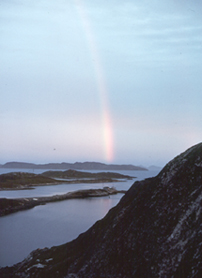
Geotimes Home | AGI Home | Information Services | Geoscience Education | Public Policy | Programs | Publications | Careers

 Earth’s oldest
rocks containing what scientists heralded as the earliest evidence for life are
under scrutiny. The rocks in question sit on Akilia Island off the southwest coast
of Greenland. The island hosts a rock exposure of dark green, almost black, mineral
layers alternating with white. Geologists first identified the outcrop as containing
banded iron formations: a type of sedimentary rock precipitated from seawater.
Earth’s oldest
rocks containing what scientists heralded as the earliest evidence for life are
under scrutiny. The rocks in question sit on Akilia Island off the southwest coast
of Greenland. The island hosts a rock exposure of dark green, almost black, mineral
layers alternating with white. Geologists first identified the outcrop as containing
banded iron formations: a type of sedimentary rock precipitated from seawater.
 |
Geotimes Home | AGI Home | Information Services | Geoscience Education | Public Policy | Programs | Publications | Careers |